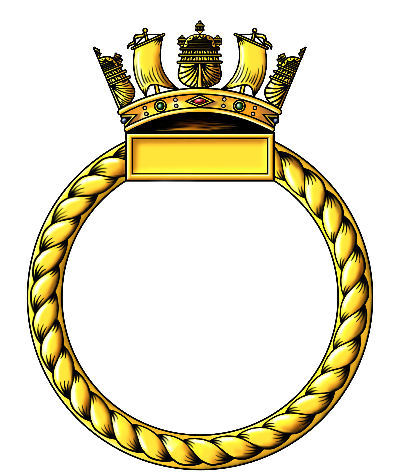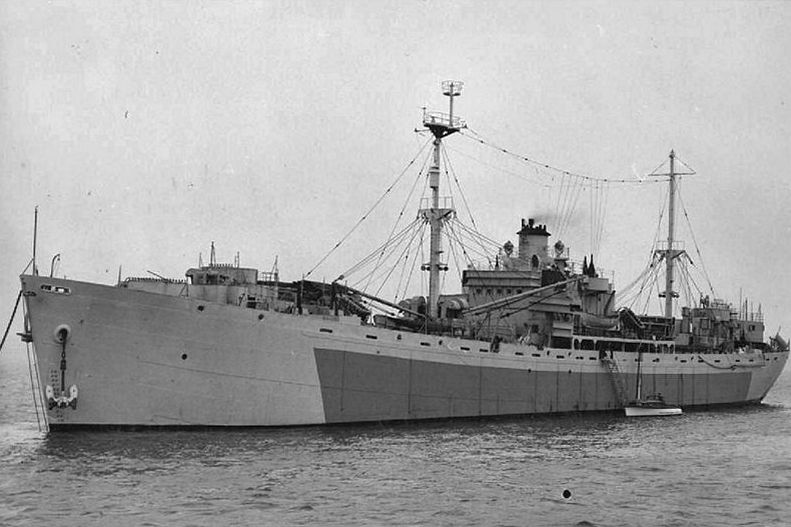Repair & Maintenance Ship

No badge issued for this ship
Battle Honours
Portland 1653
Gabbard 1653
Lowestoft 1665
Orfordness 1666
China 1858-59
Pacific 1945
Specifications
Builder: Bethlehem-Fairfield Shipyard, Inc., Baltimore, Maryland, United States
Displacement: 10,920 tons
Length: 441 ft 6 in
Beam: 56 ft 1 in
Draught: 22 ft
Speed:12.5 Knots
Crew complement: 525
Commanding Officers
Capt. (ret) James Halliburton Young, RN, 30 Aug 1944 to mid 1946
Related items
None
Reminiscences
None
Gallery
None
H.M.S. ASSISTANCE

Image copyright IWM (FL 1122)
Early history
A US Navy Xanthus class repair ship built for transfer to the Admiralty under the Lend-Lease agreement. She was laid down May 17th 1944 at the Bethlehem-Fairfield Shipyard, Baltimore as a Maritime Commission EC2-S-C1 hull, intended for completion as a Liberty ship for transfer to Britain. Instead, she was one of five of the partially completed Liberty ship hulls requisitioned by the US navy for conversion into repair ship's:
AR-17 became HMS ASSISTANCE
AR-18 became HMS DILIGENCE
AR-19 to be HMS HECLA retained by USN and became USS XANTHUS
AR-20 to be HMS DUTIFUL retained by USN and became USS LAERTES
AR-21 to be HMS FAITHFUL retained by USN and became USS DIONYSUS
AR-17 was launched on June 20th 1944 and was delivered, to the US Navy, 79% complete, on August 28th 1944. She was moved to be converted by Maryland Drydock Company, Baltimore, for fitting out as an auxiliary repair ship and was delivered to the Royal Navy on January 20th 1945. AR-17 commissioned as the following day as HMS ASSISTANCE, Captain James Halliburton Young, RN, (ret) in command. On leaving the Maryland Drydock Company Yard she was moved to pier 9, Port Covington, Baltimore for fitting out. She departed Port Covington on February 2nd and sailed from Baltimore Feb 4th for her sea trials.
HMS ASSISTANCE arrived Norfolk Navy Yard at 1715 hours on February 24th. She remained in Norfolk until March 2nd when she sailed to return to Baltimore, arriving there on the 5th. On the afternoon of March 9th HMS ASSISTANCE sailed from Baltimore for New York. She sailed for the UK as part of convoy HX.344 which departed New York City on March 14th 1945; on reaching the UK she detached from the convoy and proceeded to Plymouth, arriving at Devonport Naval Dockyard on March 28th.
Reallocated to the British Pacific Fleet
H.M.S. ASSISTANCE was nominated for service with the Fleet Train and sailed for Australia soon after her arrival in the UK. She arrived on station after the war had ended.
Post War history
She arrived at Manus on September 10th 1945 and remained there until November 15th when she departed for Singapore where she was to operate as a Harbour Repair Ship.
On Christmas Day 1945 a party of around 70 Dutch and Chinese children are welcomed aboard ASSISTANCE, anchored off Singapore, for a party hosted by the crew.
She returned to the UK in late May/early April 1946 and after being de-stored and essential equipment removed she sailed for the US. AR-17 arrived at Norfolk Navy Yard on July 30th 1946 and was decommissioned and returned to U.S. custody August 15th 1946. Transferred to the National Defense Reserve Fleet, she was mothballed in the James River and was put up for disposal Dec 13th 1946.
Last modified: 23 February 2023
Primary information sources
Additional sources:
U. S. Navy Auxiliary Vessels 1835-1945 ASSISTANCE Class Repair Ships section of the web site
Comments (0)